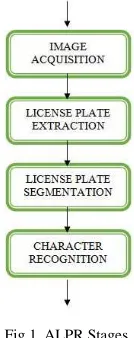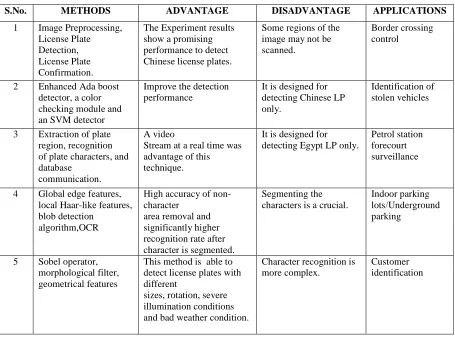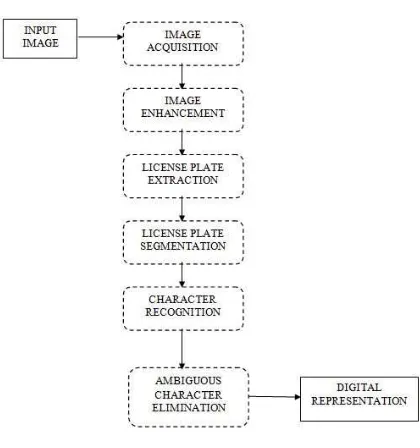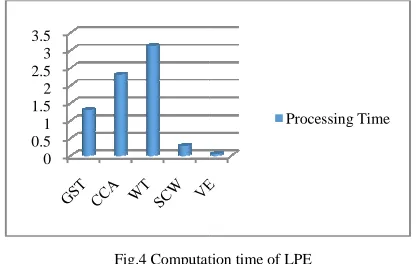256
Enhanced Automatic License Plate Recognition
Mohan Prasanth.R
1,Chitradevi.T.N
2, Senthilnathan.S
3Department of Computer Science and Engineering 1, 2, 3, Adithya Institute of Technology1, 3,Sri Ramakrishna Engineering College2
Email: mohanprasanthcs@gmail.com1,chitradevi.04@gmail.com2,senthil.sn1985@gmail.com3
Abstract— In recent years, vehicles play a very big role in mass surveillance. The use of vehicles has been increasing day-by-day because of population growth and human needs. Therefore the controlling of vehicles is becoming a major issue as a large amount of vehicles are parked in the common places. In order to have an effective surveillance of vehicles, the Automatic License Plate Recognition (ALPR) technique is preferable. The ALPR has turned out to be an important research issue. ALPR has many applications including controlling the parking lots, garbage door opening, security control of restricted areas, automatic toll collection, traffic law enforcement, etc. Which have difficulties like an illumination in the image, uneven illumination, dim light and brumous conditions make the task of image enhancement even more difficult and recognition of ambiguous and broken characters makes the character recognition challenging. In this paper categorize different ALPR techniques according to the features they used for each stage, and compare them in terms of advantages, disadvantages and processing speed and an ALPR system is developed that will overcome these issues and provide an effective and efficient mass surveillance system.
Index Terms— Automatic license plate recognition (ALPR), License plate extraction, License plate segmentation,
Character recognition.
1. INTRODUCTION
Mass surveillance is the distributive surveillance of an entire or a substantial fraction of a population. The surveillance is usually carried out by governments, often surreptitiously, but may also be done by corporations at the behest of governments or at their own initiative [1].Mass surveillance systems are useful in various applications like parking lots, Boarder Crossing Control, Identification of stolen vehicles, Red light camera ,etc. The Automatic license plate recognition system recognizes a vehicle’s license plate number from an image and processes it using various techniques like Image Acquisition (IA), License Plate Extraction (LPE), License Plate Segmentation (LPS) and Character Recognition (CR).
The ALPR system that extracts a license plate number from a given image can be composed of four stages. The first stage is to acquire the car image using a camera. The parameters of the camera, such as the type of camera, camera resolution, shutter speed, orientation, and light, have to be considered. The second stage is to extract the license plate from the image based on some features, such as the boundary, the color, or the existence of the characters. The third stage is to segment the license plate and extract the characters by projecting their color information, labeling them, or matching their positions with templates. The final stage is to
recognize the extracted characters by template matching or using classifiers, such as neural networks and fuzzy classifiers.[3]
[image:1.595.396.463.505.674.2]ALPR is also known as automatic vehicle identification, car plate recognition, automatic number plate recognition and optical character recognition (OCR) for cars. In this paper the various ALPR techniques and their pros and cons are discussed.[5]
Fig 1. ALPR Stages
E-ISSN: 2321-9637
257 illumination problem affects the accuracy and
effectiveness of the system. Where the illumination problem is that will affect the image and make it to visible in different color which is influenced by light. The presence of illumination in the image will make it to look too bright or too dull. Which will make the image extraction more complex and the success rate reduces. To overcome that a methodology is proposed which will take the acquired image and enhance it by eliminating the illumination.
The remainder of this paper is organized as follows. In Section II, Survey of literature is discussed with various methods used in each stage with their pros and cons. In Section III, Related work of ALPR is described. In Section IV Proposed method of Automatic License Plate Recognition is discussed. Section V demonstrates the experimental setup and results. Section VI describes the overall performance of the enhanced ALPR system. In Section VII describes the conclusion and future work.
2. SURVEY OF LITERATURE
RunminWang and Nong Sang propose a new license plate detection method based on the gradient information and a cascade detection.[1] This method consists of three main modules: image preprocessing, license plate detection and license plate confirmation. Considering the diversities of Chinese license plate, To first get the gradient images and unify plate forms through image preprocessing. The license plate will be detected roughly by using the cascade Ada Boost classifier in the next step. Finally, several heuristic judgment strategies and a voting-based method are used to verify the candidate license plates. This method is verified by experiments, and the experiment results show a promising performance to detect Chinese license plates. The scale factor of the cascade AdaBoost classifier is selected artificially, and the cascade AdaBoost classifier scans across the images by shifting the window some number of pixels [1].
Zhenjie Yao and Weidong Yi propose a new License Plate (LP) detection technique based on multistage information fusion, which is adopted to reduce high false alarm rate in the conventional Adaboost detector [2].The proposed Conventional Adaboost detector is enhanced by multistage information fusion for LP detection. Major modifications include: First, the Harr-like feature extraction is modified and restricted in the scale of character and stroke to accommodate for LP detection. Second, multistage information fusion is adopted to reduce false alarm rate of the conventional
Adaboost LP detector. The whole multistage information fusion system is composed of an enhanced Adaboost detector, a color checking module and an SVM detector, the latter two of which further check whether the image patch that gets through the Adaboost detector is a license plate. Because there are differences between training data and practical data, the number of weak-classifiers should be determined according to the real-world data, rather than determined by the training dataset only. Although the Fusion detector is designed for detecting Chinese LP, it can be extended for detecting LP in other countries after modifications of the color checking module [3].
LihongZheng and Xiangjian presented an algorithm for extraction (detection) and recognition of license plates in traffic video datasets. For license plate detection, To introduce a method that applies both global edge features and local Haar-like features to construct a cascaded classifier consisting of 6 layers with 160 features. The characters on a license plate image are extracted by a method based on an improved blob detection algorithm for removal of unwanted areas. This is a crucial work after the detection of license plates and before the use of OCRs for character recognition. The process is successful through the steps of character vertical height estimation, character width estimation, and segmentation of a license plate into blocks and the identifying of character blocks. The techniques used include image binarization, vertical edge detection, horizontal and vertical image projections, and blobs extraction and identification. Various well-known techniques are applied to come out with the innovative algorithm in this paper [5].
258 By making the below comparison among various
papers that yields an idea through which the sort of methods can be used for the appropriate purposes. Here, many methods have been proposed in order to
[image:3.595.72.527.188.533.2]increase the performance and improve the recognition rates.
TABLE 1. COMPARISON OF ANPR
S.No. METHODS ADVANTAGE DISADVANTAGE APPLICATIONS
1 Image Preprocessing, License Plate Detection, License Plate Confirmation.
The Experiment results show a promising performance to detect Chinese license plates.
Some regions of the image may not be scanned.
Border crossing control
2 Enhanced Ada boost detector, a color checking module and an SVM detector
Improve the detection performance
It is designed for detecting Chinese LP only.
Identification of stolen vehicles
3 Extraction of plate region, recognition of plate characters, and database
communication.
A video
Stream at a real time was advantage of this technique.
It is designed for detecting Egypt LP only.
Petrol station forecourt surveillance
4 Global edge features, local Haar-like features, blob detection
algorithm,OCR
High accuracy of non-character
area removal and significantly higher recognition rate after character is segmented.
Segmenting the characters is a crucial.
Indoor parking lots/Underground parking
5 Sobel operator, morphological filter, geometrical features
This method is able to detect license plates with different
sizes, rotation, severe illumination conditions and bad weather condition.
Character recognition is more complex.
Customer identification
3. RELATED WORK
The interest of this paper is in the automatic license plate recognition of vehicles for providing mass surveillance system. The application scenario of this system areparking lots, garbage door opening, security control of restricted areas, automatic toll collection, traffic law enforcement. There have been techniques previously developed for acquiring the image [4], License Plate Extraction [5], License Plate Segmentation [6] and Character Recognition [7].
There are many relevant works, particularly, for the detection of a text region. Most of the text detection methods can be classified as either edge based methods, connected component based methods or texture-based methods. The edge-based methods focus on the high contrast between the text and the background [8-9].
The edge density describes an image region as a whole. It is defined as
= ( , ) (1)
Where EV (i, j) is the magnitude of the vertical edge at location (i, j), and N is the number of non-zero Vertical edge pixels in the image region. The vertical edges can be computed using
( , ) = ( , ), 45° ≤ ( , ) ≤ 135°,0, ℎ"#$ %", & (2)
E-ISSN: 2321-9637
259 are normalized by the maximum gradient strength in
the image.
Assuming that the character pattern is an H _W image f(i, j),where (i, j) is the pixel at ith row and jth column (1 ≤ i ≤ H,1≤ j ≤W), then the construction of an N ×M mesh (N ≤ H,M ≤W) can be described as follows. First, the horizontal and vertical projection profiles, h(i) and v(j), are computed using
ℎ( ) = ∑+ ( , )), 1 ≤ ≤ *,
,- (3)
.( ) = ∑0 (), ), 1 ≤ ≤ /,
,- (4)
The extracted characters are then recognized and the output is the license plate number. To recognition the characters of car license plate, many techniques have been used. In [42], the feature vector is generated by dividing the binary character into blocks of 3×3 pixels. Based on this features the exploited character image is compared with the prepared sample that were known before. By rely on this base, two similar images in the same weight upon each other can deposit. So the normal factor is introduced in below shape:
NF=∑ ∑ 12,3 .52,3
6 378 9 278
∑9278∑637812,3 (5)
4. PROPOSED SYSTEM
In this section the illumination problem is been controlled. Uneven illumination and poor contrast in the digital images are the common problems associated with digital image processing. This illumination problem affects the accuracy and effectiveness of the system. Where the illumination problem is that will affect the image and make it to visible in different colour which is influenced by light.
The presence of illumination in the image will make it look too bright or too dull. Which will make the image extraction more complex and the success rate reduces. To overcome that a methodology is proposed which will take the acquired image and enhance it by eliminating the illumination.
[image:4.595.335.545.117.341.2]First, we converts RGB values to grayscale values by forming a weighted sum of the R, G, and B components, with 8 bits per pixel, which allows 256 different intensities.
Fig 2 Proposed ALPR System
The effective luminance of a pixel is calculated by the Eq
Y 0.2989*R = + 0.5870*G + 0.1140*B (6) Second, we adjust old intensity values of grayscale image to new values; the image is weighted toward lower (darker) output values
:(;< .=)
( < ) − 32678 ≤
:(;<C.=)
( < ) − 32678 (7)
Where x is the intensity value, the scale factor A is 255, because the intensity image of class uint8. Third, we convert to binary image use Otsu Method, the image converted by Eq.2
( , ) = D1 ( , ) ≥ F0 ℎ"#$ %"& (8)
where, T is some global threshold, which defined by Otsu's method, computing a global threshold (level) that can be used to convert an intensity image to a binary image, level is a normalized intensity value that lies in the range [0, 1], which chooses the threshold to minimize the intra class variance of the black and white pixels.
The recognised character can consist of the ambiguous character (i.e. B-8, o-0, I-1, a-4, c-G, D-o, k-X) which could affect the recognition rate of the system
The Proposed real time Automatic License Plate Recognition System was experimented under certain hardware and software constraints and requirements. The simulation process is carried out in MATLAB (R2012b) for the license plate localization and recognition. The hardware platform used during the experiments was based on a Intel Core i3
CPU @ 2.40 GHz processor, 4 GB of DDR3 RAM on Microsoft Windows 7 Ultimate 64
system environment.
The computation time of different license plate extraction methods are shown in Table 3. Processing time of different methods is described in seconds. Comparing all this methods GST,
and VE. Vertical edge method is best. Because it acquires high success rate in less time.
The computation time of different license plate segmentation methods are explained in Table 3 with units milliseconds. Different methods are SCW, feature projection, mathematical morphology and vertical and horizontal projection. The success rate and processing time of VHP method is best comparing all this methods.
Table 3. Computation time (s) for license plate extraction
Method TD CD FD Success %
GST 100 93 7 93.00
CCA 100 96 4 96.00
WT 100 92 8 92.00
SCW 100 96 4 93.00
[image:5.595.315.525.169.279.2]VE 100 99 1 95.00
Table 4. Computation time (ms) for license plate segmentation
Method TI SI MI Success %
SCW 100 96 4 96.00
FP 100 95 5 95.00
MM 100 84 16 84.00
VHP 100 97 3 97.00
The characters and numbers in the license plate are recognized using different kind of methods. The accuracy of methods are shown in Table 5. ANN, SVM, voting based and OCR methods are used. The Proposed real time Automatic License Plate Recognition System was experimented under certain hardware and software constraints and requirements. The simulation process is carried out in MATLAB (R2012b) for the license plate localization and The hardware platform used during the experiments was based on a Intel Core i3-2370M CPU @ 2.40 GHz processor, 4 GB of DDR3 RAM ws 7 Ultimate 64-bit operating
The computation time of different license plate extraction methods are shown in Table 3. Processing time of different methods is described in seconds. CCA, WT, SCW ertical edge method is best. Because it acquires high success rate in less time.
The computation time of different license plate segmentation methods are explained in Table 3 with units milliseconds. Different methods are SCW, atical morphology and vertical and horizontal projection. The success rate and processing time of VHP method is best
Computation time (s) for license plate extraction
Success Processing Time(s)
93.00 1.3s
96.00 2.3s
92.00 3.12s
.00 0.276s
.00 0.0492s
Computation time (ms) for license plate segmentation
Success Processing Time(ms)
96.00 276ms
95.00 220ms
84.00 160ms
97.00 45ms
The characters and numbers in the license plate are recognized using different kind of methods. The accuracy of methods are shown in Table 5. ANN, SVM, voting based and OCR methods are used.
Evaluating all this methods OCR method obtains high accuracy percentage in recognition.
Table 5. License plate recognition
Method
Character
ANN 56.45
SVM 45.63
Voting Based 85.3
OCR 88.9
The overall performances of automatic license plate recognition based on speed are
6. The performances are evaluated using all the above methods explained in different tables.
6. PERFORMANCE ANALYSIS
The performance analyses of different automatic license plate recognition methods are
vertical edge detection m
plate extraction. Extraction accuracy and processing time are explained in the graph as shown in Fig. 1. This method obtains 95 percent accuracy comparing to all other methods.
Fig.4 Computation time of LPE
The number plates are segmented after extracted from the image. The extracted images are segmented using different set of methods based on their appearance features. The vertical and horizontal projection method improves the performance of segmentation. It obtains 97 percen
and processing time is 45ms. Algorithm performance is shown in Fig. 2.
0 0.5 1 1.5 2 2.5 3 3.5 260 Evaluating all this methods OCR method obtains
entage in recognition.
License plate recognition
Category Character Number
75.36
89.65
69.6
92.2
The overall performances of automatic license plate recognition based on speed are shown in Table 6. The performances are evaluated using all the above methods explained in different tables.
PERFORMANCE ANALYSIS
The performance analyses of different automatic license plate recognition methods are discussed. The vertical edge detection method s used for license plate extraction. Extraction accuracy and processing time are explained in the graph as shown in Fig. 1. This method obtains 95 percent accuracy comparing
Fig.4 Computation time of LPE
are segmented after extracted from the image. The extracted images are segmented using different set of methods based on their appearance features. The vertical and horizontal projection method improves the performance of segmentation. It obtains 97 percentage of success rate and processing time is 45ms. Algorithm performance
[image:5.595.314.522.449.581.2]Fig. 5 Computation time of LPS
The characters and numbers in the license plate are recognized after segmentation. Comparing different set of methods OCR method
performance of character and number are explained in Fig. 3. It obtains 88.9 and 92.2 percent accuracy in recognition.
Fig.6 Character and Number Recognition
7. CONCLUSION
This paper provides an enhanced mass surveillance system which takes the vehicle image as the input and processes it and recognizes the number plate present in it and displays it to the users. The performance of the developed algorithms for Automatic License Plate Recognition is found reasonable competing with the existin
algorithms. The developed algorithms accurately identify the License Plates given as input. These algorithms are experimented and the results are obtained. The obtained results are compared and analyzed. The major findings from these tests are: Primary advantages of automated license plate reading include the use of all license plate characters in matching for increased accuracy and ability to read the poor quality of vehicles images. (2) The major limitations of automated license plate readi
constraints on camera location and positioning, limited success in less-than-ideal conditions, and the evolving machine vision technology.
0 50 100 150 200 250 300
SCW FP MM VHP
0 20 40 60 80 100
ANN SVM VB OCR
E-ISSN: 2321-9637
Fig. 5 Computation time of LPS
The characters and numbers in the license plate are recognized after segmentation. Comparing different set of methods OCR method is best. The performance of character and number are explained in Fig. 3. It obtains 88.9 and 92.2 percent accuracy in
Fig.6 Character and Number Recognition
This paper provides an enhanced mass surveillance s the vehicle image as the input and processes it and recognizes the number plate present in it and displays it to the users. The performance of the developed algorithms for Automatic License Plate Recognition is found reasonable competing with the existing class of algorithms. The developed algorithms accurately identify the License Plates given as input. These algorithms are experimented and the results are obtained. The obtained results are compared and analyzed. The major findings from these tests are: (1) Primary advantages of automated license plate reading include the use of all license plate characters in matching for increased accuracy and ability to read the poor quality of vehicles images. (2) The major limitations of automated license plate reading include constraints on camera location and positioning, ideal conditions, and the evolving machine vision technology.
REFERENCES
[1] G. Liu, Z. Ma, Z. Du, and C. Wen, “The calculation method of road travel time based on license plate recognition technology,” in Adv. Inform. Tech. Educ. Commun. Comput. Inform. Sci., vol. 201. 2011, pp.
[2] Y.-C. Chiou, L. W. Lan, C.
Fan, “Optimal locations of license plate recognition to enhance the origin
matrix estimation,” in Transp. Stu., vol. 8.2011, pp. 1
[3] S. Kranthi, K. Pranathi, and A. Srisaila, “Automatic number plate recogni
Adv. Tech., vol. 2, no. 3, pp. 408
Wan, J. Liu, and J. Liu, “A vehicle license plate localization method using color barycenters hexagon model,” Proc. SPIE
80092O-1–80092O-5, Jul. 2011. [4] B. K. Cho, S. H. Ryu,
“License plate extraction method for identification of vehicle violations at a railway level crossing,” Int. J. Automot. Tech.
no. 2, pp. 281–289, 2011. [5] M.-L. Wang, Y.-H. Liu, B.
M.-F. Horng, “A vehicle license plate recognition system based on spatial/frequency domain filtering and neural networks,” in
Collective Intell. Tech. Applicat. 2010, pp. 63–70
[6] Y. Lee, T. Song, B. Ku, S. Jeon, D. K. Han, and H. Ko, “License plate detection using local structure patterns,” in
Video Sigal Based Surveillance 574–579.
[7] S. Mao, X. Huang, and M. Wang, “An adaptive method for Chinese license plate location,” in Proc. World Congr. Int
2010, pp. 6173–6177.
[8] Wang, Runmin, Nong Sang, Rui Huang, and Yuehuan Wang. "License plate detection using gradient information and cascade detectors." Optik-International Journal for Light and Electron Optics 125, no. 1 (2014): 1
[9] Yao, Zhenjie, and Weidong Yi. "License plate detection based on multistage information fusion." Information Fusion
[10] Massoud, M. A., M. Sabee, M. Gergais, and R. Bakhit. "Automated new license plate recognition in Egypt."
Journal 52, no. 3 (2013): 319
[11] Zheng, Lihong, Xiangjian He, BijanSamali, and Laurence T. Yang. "An algorithm for accuracy enhancement of license plate recognition."
Processing Time
Character
Number
261 [1] G. Liu, Z. Ma, Z. Du, and C. Wen, “The
calculation method of road travel time based on license plate recognition technology,” in Proc. Adv. Inform. Tech. Educ. Commun. Comput.
, vol. 201. 2011, pp.
C. Chiou, L. W. Lan, C.-M. Tseng, and C.-C. Fan, “Optimal locations of license plate recognition to enhance the origin-destination matrix estimation,” in Proc. Eastern Asia Soc.
, vol. 8.2011, pp. 1–14
[3] S. Kranthi, K. Pranathi, and A. Srisaila, “Automatic number plate recognition,” Int. J. , vol. 2, no. 3, pp. 408–422, 2011. X. Wan, J. Liu, and J. Liu, “A vehicle license plate localization method using color barycenters Proc. SPIE, vol.8009, pp. 5, Jul. 2011.
[4] B. K. Cho, S. H. Ryu, D. R. Shin, and J. I. Jung, “License plate extraction method for identification of vehicle violations at a railway Int. J. Automot. Tech., vol. 12, 289, 2011.
H. Liu, B.-Y. Liao, Y.-S. Lin, and , “A vehicle license plate recognition system based on spatial/frequency domain filtering and neural networks,” in Proc. Comput. Collective Intell. Tech. Applicat., LNCS 6423.
[6] Y. Lee, T. Song, B. Ku, S. Jeon, D. K. Han, and nse plate detection using local structure patterns,” in Proc. IEEE Int. Conf. Adv. Video Sigal Based Surveillance, Sep. 2010, pp.
[7] S. Mao, X. Huang, and M. Wang, “An adaptive method for Chinese license plate location,” in Proc. World Congr. Intell. Control Automat.,
[8] Wang, Runmin, Nong Sang, Rui Huang, and Yuehuan Wang. "License plate detection using gradient information and cascade detectors." International Journal for Light and
125, no. 1 (2014): 186-190. [9] Yao, Zhenjie, and Weidong Yi. "License plate
detection based on multistage information Information Fusion 18 (2014): 78-85. [10] Massoud, M. A., M. Sabee, M. Gergais, and R.
Bakhit. "Automated new license plate recognition in Egypt." Alexandria Engineering
52, no. 3 (2013): 319-326.
262 Journal of Computer and System Sciences 79,
no. 2 (2013): 245-255.
[12]Lalimi, MahmoodAshoori, SedighehGhofrani, and Des McLernon. "A vehicle license plate detection method using region and edge based methods." Computers & Electrical Engineering 39, no. 3 (2013): 834-845.



